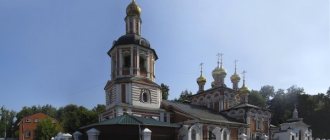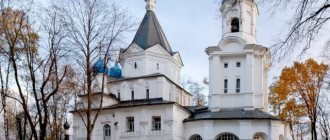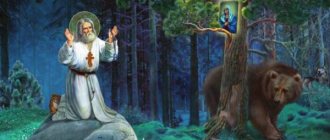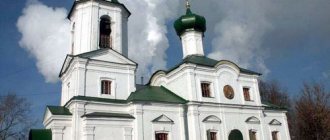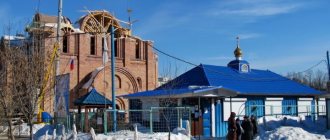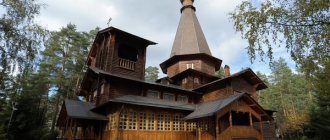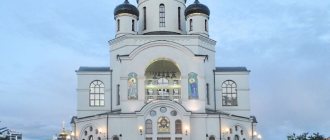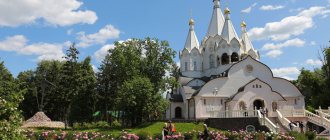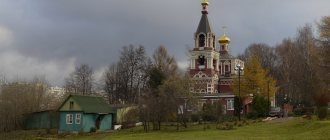| St. Stefan Permsky |
Stefan of Perm
(c. 1340 - 1396), Bishop of Great Perm, saint, enlightener of Perm, apostle of the Zyryans Memory on April 26, in the Cathedrals of Arkhangelsk, Komi, Moscow and Radonezh saints
Born around 1340 in the city of Ustyug in the family of the cleric Simeon. When the future mother of the saint, Mary, was still three years old, the Ustyug saint Procopius the Fool foretold her the birth of a holy son [1]. Under the influence of his pious mother, possessing great abilities, Stephen from a young age showed extraordinary zeal for serving the Church: in one year he learned to read and helped his father in church during divine services, fulfilling the position of canonarch and reader.
In his youth, the saint accepted monasticism in a monastery in honor of St. Gregory the Theologian in Rostov. The monastery was famous for its rich book collection. Saint Stephen wanted to read the Holy Fathers in the original and for this he studied Greek. In his youth, helping his father in church, he often talked with the Zyryans. Now, having mastered the rich church culture, Saint Stephen was eager to convert the Zyryans to Christ.
To educate the Zyryans, the future saint compiled the alphabet of their language and translated several church books into it. To compile the Zyryan alphabet, he used the Zyryan money badges, which they carved on thin quadrangular sticks (passes). Rostov Bishop Arseny (1374-1380) ordained him to the rank of hierodeacon. Having prepared himself for missionary activity, Saint Stephen appeared in Moscow in 1379 to Bishop Gerasim of Kolomna, who was then managing the affairs of the metropolis, and asked him: “Bless me, Vladyka, to go to the pagan country of Perm. I want to teach the holy faith to unfaithful people. I decided to either lead them to Christ, or lay down their heads for Christ.” The bishop joyfully blessed him and ordained him to the rank of hieromonk. He provided him with antimensions, holy myrrh and liturgical books, and Grand Duke Dimitri Ioannovich gave him letters of safe conduct.
From Ustyug, Saint Stephen descended along the Northern Dvina to the confluence of the Vychegda, where the Zyryan settlements began. He was met with extreme hostility: they laid out a fire of wood, and they wrapped him in straw to burn him; but no one dared to approach him with a lit torch. His meek appearance and fearlessness disarmed the Zyryans, and they themselves began to ask him to preach to them. The preacher of the faith of Christ endured much labor, struggle, hardship and sorrow, living among the pagans who worshiped idols, “fire, water, trees, stones, and the golden woman, and the magician, and the sorcerer, and the tree.”
The Zyryans were especially in awe of the so-called “sweet birch tree.”
A birch tree [2] enormous in thickness and height grew on an elevated place. The Zyryans gathered to her and sacrificed the animals they had caught. Saint Stephen set up his cell not far from the birch tree and used the meetings of superstitious pagans around the tree to teach them the holy truth. Saint Stephen then cut down and burned the birch tree to eradicate superstition. The Zyryans were going to kill him. The saint addressed them with a sermon: “Judge for yourself, are your gods strong when they cannot protect themselves from fire?
Are they gods when they are so weak and lack not only sense, but also hearing and sight? And your deity was unable to protect itself from me, the weak one. Are not all your other gods like this? This is not the Christian God. He sees everything, knows everything and is Almighty, for he created the whole world and provides for everything. And how good He is, especially to those who know Him! I wish you well by preaching the True God to you. He will love you and do good to you when you begin to honor Him sincerely.” On the site of the “weedy birch”, Saint Stephen built a temple in honor of Archangel Michael, the destroyer of the spirits of darkness.
The baptized Zyryans themselves began to destroy what they had previously worshiped: they cut down sacred trees, crushed idols; They brought rich gifts intended for pagan altars to Saint Stephen. He ordered the Zyrian resident Matthew, who served with him, to set everything on fire and only allowed the linen to be used for wrapping the legs.
But the final turning point in the Zyryans occurred after Saint Stephen disgraced their chief priest Pam [3], who rebelled against the spread of the holy faith. The priest entered into an argument with Saint Stephen. “You Christians,” said Pam, “have one God, and we have many helpers both on land and on water, giving us happy fishing in the forests and supplying Moscow, the Horde and distant countries with its abundance; they tell us in sorcery secrets that are inaccessible to you.” Saint Stephen answered that there is only one True God; Omnipotence is one thing, but the powerlessness of the idol gods is obvious from experience. After much debate, the priest Pam, in order to justify his faith, volunteered to go through fire and water and demanded the same from Saint Stephen. “I do not command the elements,” Saint Stephen humbly answered, “but the Christian God is great: I am going with you.” Pam trembled and begged to be spared from certain death. “You are witnesses,” Saint Stephen said to the assembled people, “he himself demanded that the dispute about faith be resolved by fire and water, and yet he does not want to be baptized. Who should we consider Pam to be now? What to do with him?" “The deceiver must be put to death,” the people answered, “if you let Pam go, he will do dirty tricks on you.” “No,” answered the saint, “Christ did not send me to put anyone to death, but to teach. Pam does not want to accept the saving faith, let his stubbornness punish him, but not me.” Pam was kicked out. In gratitude to the Lord for the victory over the leader of the pagans, Saint Stephen built a temple on Vishera in honor of Saint Nicholas. After this, the saint’s preaching about Christ began to become more and more successful.
In 1383, Saint Stephen was installed by Metropolitan Pimen as Bishop of Perm. As a loving father, he tirelessly cared for his flock. To confirm the faith of converts, Saint Stephen opened schools at churches where sacred books were studied in the Permian language. The saint looked closely at the students, took into account their abilities in order to appoint priests and deacons from them. Saint Stephen taught some students to write in Permian. The saint built churches in which he appointed priests from the Zyryans, and introduced worship in the Zyryans language. Saint Stephen translated into the Zyryan language the Book of Hours, the Psalter, selected readings from the Gospel and the Apostle, the Book of Paremias, the Stichirarion, the Octoechos, several festive services and the Divine Liturgy.
During crop failure, the Saint supplied the Zyryans with bread, many times delivered them from violence and bribes of the tiuns, eased their taxes, protected them from attacks by other tribes, interceding for them in Moscow. The fruit of his exploits and virtues was the conversion of the entire vast Perm land to Christianity - he himself baptized the population of Little Perm (later - the Komi region, i.e. the Vychegda River basin) [4], and then the Faith was spread by his students and followers. This great deed was accomplished by the power of faith and Christian love. The life of the saint is a victory of faith over unbelief, of love and meekness over malice and wickedness.
Touching is the “absentee meeting” of St. Stephen of Perm with St. Sergius of Radonezh, which took place in 1390 during the saint’s trip to Moscow on church affairs. Saint Stephen passionately loved the Radonezh ascetic and really wanted to see him on his way from the Perm land, but he could not do this due to lack of time. Being 10 miles from the monastery of St. Sergius, Saint Stephen, having prayed, turned towards the monastery and said with a bow: “Peace be with you, spiritual brother!” The Monk Sergius, who was sitting with the brethren at the meal, stood up, prayed and, bowing in the direction where the saint was passing, answered: “Rejoice, you too, shepherd of the flock of Christ, and may the peace of God be with you!” The deep spiritual connection between St. Stephen of Perm and St. Sergius of Radonezh is now evidenced by the special daily prayer to them at the fraternal meal.
In addition to establishing churches, Saint Stephen founded several monasteries for the Zyryans: Spasskaya Ulyanovsk hermitage 165 versts from Ust-Sysolsk, Stefanovskaya monastery 60 versts from Ust-Sysolsk, Ust-Vymskaya Arkhangelsk, Yarenskaya Arkhangelsk.
Saint Stephen is also credited with painting several icons. The most famous of them is the “Zyryan Trinity” with an extensive inscription in the Stefanov alphabet in the Komi language [5].
In 1395, Saint Stephen again went to Moscow on the affairs of his flock and died here on April 26, 1396.
Temple of Stephen of Perm today
The Temple of Stephen of Perm is located in a very picturesque place in South Butovo. 750 m south of the temple there is a metro station. “Buninskaya Alley”, and right behind it flows the small river Koryushka.
The temple is named in honor of the bishop of the Russian church Stefan of Perm. This righteous man lived at the beginning of the 14th century. and served in the Perm diocese all his life. He is the author of the work on translating ancient Permian writing into Russian.
Also, the hand of Stephen of Perm belongs to the “Holy Trinity” icon, painted after 1379. Art historians consider this icon to be an adaptation of Andrei Rublev’s “Trinity”. There are only 3 Orthodox churches in the district, which makes the Temple of Stephen of Perm an important element in the preservation and strengthening of Christianity in the south of Moscow. All of them belong to the southwestern vicariate of the Moscow diocese.
Interlocutor of Sergius of Radonezh
In the Assumption Cathedral of the Trinity-Sergius Lavra there is an interesting icon of the “Holy Disciples of Sergius”. The host of elders is divided into two parts: sixteen figures are depicted on the left, and fifteen on the right. At the head of the saints and saints is Sergius of Radonezh and his successor Nikon. Among the saints there are also Abbot Andronik, St. Theodore of Simonov, St. Micah, Archimandrite Dionysius, Dmitry of Prilutsky, Maxim the Greek, St. Serapion of Novgorod and others. The elders are depicted together in the icon, but in fact many of them lived in different centuries.
Saint Stephen of Perm is also on the icon of the “Disciples of Sergius” in the Dormition Cathedral of the Lavra. His face is placed in the second row directly above the head of St. Sergius. In 1981, a new holiday of the “Council of Radonezh Saints” was established in the Russian Church. The number of these saints included not only the disciples of St. Sergius, but also all the righteous who were in any way connected with the Trinity Monastery. A special number of “interlocutors” of St. Sergius are also considered Radonezh saints. They were not students, but contemporaries and like-minded people of the monk. One of these “interlocutors” is St. Stephen of Perm.
The meeting and conversation between two saints of the 14th century took place at a distance of about ten kilometers: Sergius was in his Trinity Monastery, and Stefan was near the village of Ryazantsy. In 1390, Stefan passed near the Trinity Monastery on his way to Moscow from the Perm land. He decided not to enter the monastery itself, but stopped, said a prayer and bowed towards the monastery with the words: “Peace be with you, spiritual brother!” At this time the Monk Sergius was sitting at a meal with other monks. He felt Stephen’s greeting, stood up from the table and said: “Rejoice, you shepherd of Christ’s flock, and may the peace of God be with you!” Those sitting at the table were surprised that the mentor greeted someone invisible. Sergius explained to the monks: “I stood up when Bishop Stefan was walking along the road to the city of Moscow and opposite our monastery I bowed to the Holy Trinity and blessed us, the humble ones.”
At the place where Saint Stephen stopped and bowed to Sergius, a memorial cross was erected, and then a chapel. Before the revolution of 1917, a special ritual was observed in memory of this miracle in the Trinity-Sergius Lavra. On holidays, during the third course of the meal, when the bell rang, the monks stood up, prayed and said “Amen.”
History of foundation, construction
The Temple of Stephen of Perm in South Butovo was built as part of the city program for the construction of 200 churches in the capital and its surrounding areas. The laying of the first stone took place on September 28, 2011.
Some statistics:
- The area of the occupied site is 0.99 hectares.
- The total area of the main building is 826.5 sq.m.
- House parable with utility block - 1389.8 sq.m.
- The total construction volume is 11890.6 sq.m.
- Construction area - 1371.9 sq.m.
At the grand opening, Patriarch Kirill, in the presence of prominent clergy and lay persons from the city government, performed the divine liturgy and the temple became open to parishioners.
Moscow Church of St. Stephen of Perm at the 1st Men's Gymnasium on Volkhonka
Saint Stephen of Perm
In the name of St. Stefan of Perm, the enlightener of the Zyryans, in old Moscow, a house church was consecrated at the famous 1st men's gymnasium on Volkhonka, from which only the building has now survived. The consecration of this gymnasium church had a deep symbolic meaning.
St. Stephen of Perm, “the enlightener of Perm and the apostle of the Zyryans,” was one of the most famous Russian saints in antiquity. He was born around 1340 in Ustyug, into a pious family of a local church clerk, and very early showed a desire for knowledge. In just a year, the capable boy learned to read the Holy Books and began to help his father as a reader at Divine services. There, in the church, he first met the Zyryans - the local, then still pagan population of the distant Perm region.
Already in his youth, St. Stefan took monastic vows in the Rostov monastery of St. Gregory the Theologian, where he spent thirteen long years. There he completely devoted himself to teaching, and, wanting to read the works of the Holy Fathers in the original, he studied Greek - fortunately, the monastery was famous for its rich library. Dream of St. Stefan began to convert the Zyryans, remembered from childhood, to Christianity, and he finally chose the path of missionary work for himself. For the blessing of St. Stefan came to Moscow in 1379. “I decided to either bring them to Christ, or lay down their heads for Christ,” he said to Bishop Gregory of Kolomna, who was then managing the affairs of the metropolis. The bishop joyfully blessed him for his preaching feat and gave him holy myrrh, liturgical books and antimensions on his journey, and the Grand Duke St. Dmitry Donskoy granted the saint safe-conduct.
To the Zyryans St. Stefan descended from Ustyug along the Northern Dvina and set up his cell near their most revered idol - the “wicked birch” to which they made sacrifices. A great crowd of people gathered here, and it was easiest to preach the true faith. And one day St. Stephen simply cut down this sacred birch tree and burned it in front of the pagans: “Judge for yourselves, are your gods strong when they cannot protect themselves from fire?” The Zyryans did not touch the preacher, many were even baptized into Orthodoxy by him, and in the place where their “weedy birch tree” grew, the saint built a Christian church in the name of the Holy Archangel Michael, the Destroyer of the spirits of darkness. All this caused bitterness among the tribesmen who remained in paganism, and especially among the chief priest named Pama. He got into an argument with St. Stephen, proving the superiority of polytheism: “You Christians have one God, but we have many helpers both on land and on water.” And he invited the saint to go through the pagan test with him through fire and water. “The Christian God is great: I go with you,” answered St. Stefan, and the priest, suddenly terribly frightened, began to ask to be spared his inevitable death in the fire. The shocked Zyryans expelled Pama, and in gratitude to God for the victory and salvation of St. Stefan built there, on Vishera, another Orthodox church in the name of St. Nicholas the Wonderworker.
God saved his faithful saint - his life passed and ended peacefully. The Zyryans loved him, respected him and listened to him. In 1383 St. Stefan was installed as Bishop of Minor Perm. He created writing and the alphabet for the Zyryans, translated the Gospels, the Apostle, the psalter, the book of hours, the Divine Liturgy into the local language, established local monasteries and churches with schools, where he taught reading and writing, protected them from bureaucratic exactions, and often traveled to Moscow to intercede for his flock .
During one such trip of the saint to Moscow in 1390, he found himself ten miles from the monastery of St. Sergius of Radonezh. St. Stephen greatly revered the Russian saint, but did not have the opportunity to see him in person. And then he bowed towards the Lavra with the words: “Peace be with you, spiritual brother!” At this time, the Monk Sergius was eating with the brethren: he stood up and also bowed in the direction where St. Stephen, answering him: “Rejoice, you too, shepherd of the flock of Christ, and may the peace of God be with you!”
And in 1395, the saint, having again arrived in Moscow, quietly and peacefully gave up his soul to God. His holy relics were laid to rest in the Kremlin Cathedral of the Savior on Bor, no matter how much the Zyryans asked to give them the body of their preacher. In the 15th century St. Stephen was canonized. And until the October Revolution, visitors to the Kremlin could venerate the relics of the saint and see his staff at the tomb. A high relief of St. Stephen was placed on the eastern facade of the Cathedral of Christ the Savior, where he is depicted with a scroll (charter) of the Permian script he created. Now this high relief has been restored.
The dedication of the home gymnasium church to the holy enlightener Stephen of Perm in the middle of the 19th century was connected with the history of this gymnasium and with the historical tradition of Russian education. The director of the gymnasium, I. Speer, believed that the educational institution entrusted to him came directly from the academic gymnasium of Moscow University, opened and consecrated with him on April 26, 1755, on the feast of St. Stefan of Perm. And although this opinion was incorrect, the dedication of the temple miraculously did not turn out to be a mistake.
View of the building of the 1st men's gymnasium from Volkhonka. 1979 www.temples.ru
Indeed, the very first Russian gymnasium opened at Moscow University in April 1755 and existed until 1830. The 1st men's gymnasium, which arose independently from it at the beginning of the 19th century, was also considered the best in Moscow in terms of education and prestige. So the dedication of the house church at the main Moscow gymnasium continued the glorious tradition of Russian higher and secondary schools. In addition, the goal of the 1st gymnasium was to prepare its students for Moscow University, which, in turn, returned excellent teachers to it, but the history of the emergence of this gymnasium had only an indirect relation to it.
It is believed that the very first predecessor of the Moscow classical gymnasium was the famous gymnasium of pastor Ernst Gluck, who was captured near Marienburg along with his cook, Marta Skavronskaya, (the future wife of Peter I, who became the Russian Empress Catherine I). A small gymnasium was located in the chambers of boyar V. Naryshkin on Pokrovka, where young men were actually prepared for Peter’s service, teaching them philosophy, rhetoric, foreign languages, etiquette and horse riding. It disbanded ten years after the death of its founder, in 1715. The academic gymnasium of Moscow University with noble and raznochinsky departments existed until 1812, and in 1830 it was transformed into the Noble Gymnasium. In the 1770s, a university boarding school opened, and many historians believed that it was on its basis that the Moscow Main Public School was created, then transformed into the 1st Men's Gymnasium. In fact, this school did not emerge from a university gymnasium or boarding school, but on the basis of the Imperial Decree of 1786. In the spirit of the educational policy of Empress Catherine II and the notorious idea of creating a “third estate” of free working citizens of the Russian Empire, the decree ordered the opening of public schools throughout Russia for the purpose of mass education of the population.
They say that the queen was inspired by the success of the Austrian educational reform, which Emperor Joseph II himself told her about. However, the approved project, developed by the irrepressible I. Betsky (creator of the Smolny Institute in St. Petersburg and the Orphanage in Moscow), had nothing in common with the Austrian experience. In Russia, small, medium and Main public schools were established in each province, with different periods of study and the number of disciplines, where “the poor could study without paying, and the wealthy for a moderate fee.” It is interesting that in the Main Public Schools, according to the founders’ plan, it was necessary to teach, in addition to Latin, “neighboring” foreign languages, that is, the languages of countries bordering the surrounding regions of Russia: Arabic and Chinese in the east, Greek in the south, but this idea did not come true. The difficulty was to recruit both teachers and students. The first were supplied mainly from seminarians, and the all-class nature of the educational institution aroused rejection among the nobility. The merchant class was in its infancy, and many still had no time for learning.
On September 22, 1786, in celebration of the coronation of the Empress, the Main Public Schools were opened in 25 provinces, including Moscow. Then he was given the property of Prince Volkonsky at the Prechistensky Gate on Volkhonka (the name of the street, as you know, came from the name of this family). In 1802, the Main Public School was transformed into the Moscow Provincial Gymnasium, and then into the 1st Men's Gymnasium, for which, at the beginning of the 19th century, an ancient house was purchased on Volkhonka, 16, also, by the will of fate, connected with Empress Catherine the Great.
Previously, this plot belonged to Princess A.G. Volkonskaya, who sold it to another homeowner, P. Ladyzhensky, and subsequently the house passed to the Dolgorukov family. When in 1775 Catherine II came to Moscow to celebrate the Kuchuk-Kainardzhi peace with Turkey and stayed in the Prechistensky Palace, built for her from the Golitsyn estate on Volkhonka, 14 (see September 21), then all nearby properties were purchased by the treasury for placement in them from the imperial court, which came for the empress from St. Petersburg. And the neighboring house, where a gymnasium was later opened, was provided for the heir of Tsarevich Paul. And when leaving Moscow, the Empress presented it to Field Marshal P.A. Rumyantsev-Zadunaisky. The house changed its owners more than once, being intended either as barracks or for the diplomatic reception of “Asian envoys,” until it was purchased for the 1st men’s gymnasium, and then it was personally rebuilt by Matvey Kazakov. However, the house soon burned down and only received a gymnasium in its walls in May 1819.
The 1st Moscow men's gymnasium was considered one of the best in terms of the quality of education: gymnasium students were directly prepared both for Moscow University and for entering the civil service. Until 1828, the four-year course included Latin, foreign languages, history, principles of philosophy and art history (“fine sciences”), grammar, and even political economy. Then the term was increased to 8 years and included the law of God, logic, literature and jurisprudence. The fundamental library of the gymnasium consisted of about 12 thousand volumes. Education was paid, and quite expensive, but commoners paid less than “noble” ones, and received government dress from the gymnasium. In addition, half of the collected funds were assigned to bonuses for the best teachers, and from the second half of the funds were paid to poor students. By the way, high school students were kept under strict discipline. They were forbidden to walk on Kuznetsky Most and Tverskoy Boulevard, appear in taverns and coffee shops, wear summer “freeform” caps and colored or striped shirt collars...
The first director of the gymnasium was the historian P.M. Druzhinin, the famous literary critic Apollo Grigoriev also taught here. But mainly the gymnasium became famous for the names of its students: historians P. Pogodin, S.M. Solovyov, P.N. Miliukov, writers A.N. Ostrovsky, Ilya Erenburg, poet Vyacheslav Ivanov, philologist A.Ibolevsky, philosopher Vladimir Solovyov and anarchist prince P.A. Kropotkin, who, by the way, did not like studying here, N.I. Bukharin, mathematician N.Ya. Bugaev, the father of Andrei Bely - almost all of them went from here to Moscow University.
In 1831, for the growing gymnasium, they bought a neighboring house on Volkhonka, 18, which belonged to the Volkonsky princes and passed on to the Ermolovs. (At one time it was rented by Alexander Herzen’s father, I.A. Yakovlev.) It housed part of the gymnasium classes, the office and the director’s apartment. Thus, the gymnasium became associated with the name of Pushkin, when its director was Okulov, married to the sister of the poet’s closest friend, Pavel Nashchokin. On his last visit to Moscow, Pushkin paid visits to both, and visited Okulov at his government apartment on May 7, 1836. Since 1852, part of this house was occupied by the administration of the Moscow educational district.
And already in October 1854, Saint Philaret, Metropolitan of Moscow, consecrated the home church of the gymnasium. It is interesting that the decree of St. The Synod on the establishment of a gymnasium church was signed with the Highest permission. Until 1887, casual priests served here, and in 1889, their own full-time clergy positions were established. At the beginning of the twentieth century, the head of the temple, Ivan Grigoriev, decorated it with silver, gilded and enamel, vestments on the iconostasis images, built beautiful Royal Doors, an expensive bronze latticework, a silver gilded cross in an oak frame, and even installed electric light in the temple and in the assembly hall of the gymnasium. . It was here, in the assembly hall of the 1st gymnasium, that A. Ivanov’s painting “The Appearance of Christ to the People” was exhibited.
Of course, this gymnasium was not the only one in Moscow: in the middle of the 19th century there already existed the 2nd gymnasium in Elokhov, in the Musin-Pushkin estate, and the 3rd on Malaya Lubyanka, and the 4th in Pashkov’s house, and then moved to the famous Apraksin estate on Pokrovka. In the post-reform era, private male gymnasiums also appeared, like Polivanova on Prechistenka and Kreismana on Petrovka. However, loud glory still remained with the 1st on Volkhonka, so that in 1864 it, overcrowded, had to be divided into two and a new, 5th men's gymnasium with the same address was formed from its parallel classes. And then the student Vladimir Solovyov, who was immediately accepted into the third grade of the 1st male gymnasium, turned out to be a student of the 5th gymnasium, which he graduated with a gold medal, having received an impeccable certificate with the right to admission without exams to any higher educational institution in Russia, including University of Moscow.
Another contribution of the historic house on Volkhonka to Russian education took place in November 1872, when the Moscow Higher Women's Courses of Prof. Gerye is the first higher education institution for women in Moscow. (In Soviet times, they were transformed into the Lenin Pedagogical Institute, now the Moscow State Pedagogical University.)
The topic of female education, a sore point in pre-revolutionary Russia, required immediate resolution in the post-reform era. State women's gymnasiums have been created since 1862 by the Department of Institutions of Empress Maria, but with strong differences from men's. Women were supposed to be taught only pedagogical disciplines; Greek was not taught. Only one Moscow gymnasium, Fischer, operated according to the programs of men's classical gymnasiums, with the teaching of ancient languages and mathematics. Women were still prohibited from entering higher educational institutions and, most importantly, university, even by the post-reform charter of 1863. The government still had to make concessions due to student unrest and the unstable political situation. In 1869, Minister of Public Education Count D.A. Tolstoy allowed the opening of women's educational courses in St. Petersburg and Moscow, mainly pedagogical and medical. However, all of them were not higher educational institutions, giving students only the knowledge of male gymnasiums and preparing primary school teachers. A skillful, influential organizer was required, which was Professor V.I. Guerrier.
The authorities agreed to the creation of a higher educational institution for women in Moscow, but only as a private and not a state educational institution. And on November 1, 1872, the grand opening of the Moscow Higher Women's Courses took place on Volkhonka, from which higher women's education in Russia began. At the opening, the rector of Moscow University himself, historian S.M., gave a speech. Soloviev, enrolled in the teaching staff along with V.I. Klyuchevsky, A.N. Veselovsky and other university professors. Any woman who had a certificate of secondary education or had passed the entrance exams in history and literature could enroll in the courses. However, at that time, an excellent education meant little for the future activities of graduates, since they were not accepted into the university and did not have a diploma, but received only a certificate of “listening” to lectures, without specialization.
Nevertheless, the authority of the courses was recognized throughout Russia, and their program subsequently approached the university level. In the revolutionary summer of 1905, Guerrier was fired from his position as course director and V.I. was invited. Vernadsky, who refused due to his election as assistant rector of Moscow University. And the famous scientist S.A. became the new director of the courses. Chaplygin, whose name still bears a modest street on Pokrovka leading to Bolshoy Kharitonyevsky Lane. And two years later, they began to build their own building for the courses on Malaya Tsaritsynskaya, now M. Pirogovskaya Street, where the Pedagogical University still operates.
On February 24, 1918, Lenin issued a decree on the separation of the Church from the state and the school from the Church. All house churches in educational institutions were subject to liquidation. In the same mournful year, all Moscow gymnasiums were closed, and the “Chinese University” (University of the Toilers of the East) was located in the historical building on Volkhonka. According to the oral recollections of a local old-timer, his students burst into services at the Cathedral of Christ the Savior and pushed rolled up paper balls into candlesticks so that the believers could not light a candle. Then the building was replaced by several more important “guests”: among them were the Moscow Forestry Institute, and the Ministry of Forestry and Woodworking Industry, and the editorial office of the scientific publication “Literary Heritage”, and the Academic Institute of the Russian Language.” The house was not under state protection until recently, when it was offered for her by the Moscow government for the celebration of Pushkin’s anniversary.
Architect, exterior decoration, architectural ensemble
The Temple of Stephen of Perm in South Butovo was built in the best traditions of modern thought, preserving traditions dating back to the times of Kievan Rus. The building has a square at its base. Its snow-white walls rise up, overlapping with arches on which rests the main onion dome in the center and 4 small domes in the corners.
Vertically elongated windows carry a Roman trace, because Christianity spread in Rus' precisely thanks to them. Only occasionally on the roof is a light green color covering the arches and contrasting with the blinding wall from the sunlight. The construction of the temple was supervised by two architects - A.V. Nadysev and V.V. Boyko.
The architectural ensemble of the temple complex includes not only the main building, but also a parable house, a church shop, various utility buildings and even a car parking lot. There is a small park within walking distance from the temple.
Short story
The first mention of St. Stephen's Cathedral in Vienna in documentary sources dates back to 1137: in them it appears as a Romanesque church. In the mid-12th century there were only four churches in Vienna, and only one of them received parishioners. The capital urgently needed a new monastery, so the authorities decided to build a cathedral outside the city walls. The consecration of the church took place already in 1147, but it is believed that by that time the building was not completely rebuilt. At the beginning of the 13th century, a large-scale expansion of the cathedral began: part of the western wall, made in that period in the Romanesque style, has survived to this day. In 1258, there was a fire in the church, apparently minor, since by 1263 it had been restored and reconsecrated.
Presumably, in 1304, thanks to donations from Duke Albert II, it was possible to initiate the construction of the eastern part of the cathedral. The grand opening of the famous Albert Choirs took place in 1340. About a century later, the South Tower of the temple was erected, which for a long time was considered the tallest in Europe. But the North Tower, designed to be symmetrical with the South Tower, was never completed. In 1511, its construction was frozen due to the approaching Ottoman threat, which is why all efforts were devoted to fortifying the city walls. In 1711, the heaviest cathedral bell in Austria, Pummerin, weighing more than 21 tons, was installed in the North Tower.
During the Second World War, the cathedral managed to survive without receiving serious damage, but during the offensive of Soviet troops in 1945, vandals set fire to shops located next to the temple. The flames spread to the church, as a result of which its roof completely burned out, many valuable artifacts and works of art were destroyed, and the bell from the North Tower fell. With the active financial support of the federal states, the structure was restored in 7 years, and in 1952 its grand opening took place, marked by the triumphant return of the newly cast bell.
The restoration of this cathedral in Austria continues to this day. The damage caused to the temple by fire can be clearly seen today in its charred outer walls. However, the reconstruction of the building is in full swing: already this year the repaired organ damaged by the fire should return to the cathedral. It is also planned to restore its North Tower in the coming years.
Shrines and relics
Information about the shrines of the temple is located in the table:
Temple of Stephen of Perm, Moscow. Icon of St. Stephen, Bishop of Great Perm.
| Icon name | Number of prayers | Memorial Days |
| St. Stephen, Bishop of Great Perm | 2 | 9th May |
| St. Nicholas, Architectural World of Lycia, wonderworker | 4 | May 22 and December 19 |
| Matrona of Moscow | 2 | March 8, May 2, September 3, October 5, November 22 |
| Sergius of Radonezh | 3 | July 18 and October 8 |
| Equal to the Apostles Grand Duke Vladimir | 1 | July 28th |
| Venerable Stylian of Paphlagonia (Child Protector) | 1 | 9th December |
| St. Spyridon of Trimifuntsky | 2 | December 25 |
Clergy, mentors
Archpriest Vladimir Vitalievich Kovtunenko. Born in 1963. Studied at the Institute of Physics and Technology, served in the Airborne Forces. Married, father of three children. Since 1994, he changed his worldly life to a spiritual one. Since 2011, with the blessing of Patriarch Kirill, he was appointed rector of the Church of Stephen of Perm.
The regular priest of the temple is Priest Dimitry Olegovich Samsonov. He was born in 1985, graduated from the Institute of Electronics and Mathematics, and in 2013 from the Theological Seminary. Ordained since 2014
The church’s treasurer, Olga Anatolyevna Sigalaeva, also works at the temple, the Sunday school is headed by director Natalya Alekseevna Kutikova, and Irina Vyacheslavovna Kukhtinskaya is responsible for conducting catechetical services.
Social work, everyday life
The parish of the temple works closely with the Khatunsky boarding school for the elderly and disabled. Most of the people living there are single people who have lost contact with relatives. The clergy of the temple provides social, psychological and other assistance to these people.
The archpriest of the church is working to create a team of volunteers to help low-income families, participate in charity events and simply do good deeds. To join the squad, you can fill out an application online and contact them directly. Homeless people in need of treatment or sanitation, as well as those who, for one reason or another, find themselves without documents, can turn to the temple for help.
There is also a youth ministry on the temple grounds. The clergy of the temple is trying to rally young people around them in the form of a church community that would become a second family.
It carries out the following activities:
- educational work;
- missionary service;
- social service;
- all possible assistance during worship;
- classes with Sunday school students;
- economic obediences in the parish.
Among young people there are two age groups: 19-21 years old and 29-31 years old. Working at the temple, young people absorb the knowledge of true worldly and spiritual values, see the necessary guidelines and receive support from the clergy, allowing them to reveal the inner potential of each person.
Shrines[edit]
Icon of St. Stephen of Sourozh
Thanks to the help of many believers and the efforts of the rector of the temple, Archpriest Stephen, more than 150 pieces of relics have recently appeared in the church. The shrines came to the temple through the Jerusalem Patriarchate, they have all the corresponding Certificates. These are the relics of not only many holy saints, but even a piece of the chiton (tunic) of the Savior from the city of Trier, a cross with a piece of the wood of the Life-giving Cross of the Lord, a piece of the vestment of the Most Holy Theotokos (in which the Mother of God was at the time of the birth of Jesus Christ) from the city of Chartres, as well as particles of the relics of the patrons of children - rights. Simeon the God-Receiver, St. Stylian of Paphlagonia and St. Julian of Cenomania...
Some of the relics are already in icons of the same name, some are in arks.
Sunday School
Since the day of its foundation, the church has had a Sunday school located in the house of the parable. Main classes are held on Saturdays from 10 a.m. to 4 p.m. Bright, well-equipped classrooms, a spacious assembly hall, a dining room and a library - everything here is created so that children can gain new knowledge every day.
The school is designed for 100 students, 17 teachers work here, who, in addition to subjects, also lead creative clubs.
The main subject is the Law of God, schoolchildren receive in-depth knowledge of church literature and the Old Church Slavonic language. There are also music classes, a developmental program “Synthesis” and a creativity lesson. During breaks between classes, students eat meals.
At clubs and sections, school students can receive additional education in piano, flute or six-string guitar, learn vocals or art, develop public speaking, gain crocheting and knitting skills, or engage in cutting and sewing. There is a theater studio "Blue Bird".
In addition to classes, the school conducts:
- Reading reports and presentations.
- Quizzes.
- Musical and literary evenings.
- Scientific and educational conferences.
- Pilgrimage trips and excursions.
- Fairs of creative works.
Interesting Facts
It is noteworthy that Patriarch Kirill of the Russian Orthodox Church took a direct part in the consecration of the temple. On October 1, 2013, Bishop Theophylact of Dmitrov performed the rite of minor consecration of the temple.
The church has a circle “The Basics of Orthodoxy”, where people who show interest in the Christian faith can get acquainted with the Church Sacraments, chat on biblical topics, learn about the Dogmas of Theology and Liturgics, and also get acquainted with the exploits of faith of the Russian new martyrs.
The church welcomes people who, due to some circumstances, have renounced the Orthodox faith, but over time have changed their minds and want to return to the fold of the Orthodox Church.
The temple has its own personal website: svt-stefan_ru. The information on it is constantly updated, allowing you to monitor the life and activities of the temple. The clergy leads a group on VKontakte, where they introduce the owners of pages on this social network with news in the life of the temple.
Where is it located, what is in the surrounding area, how to get there
To get to the temple by car, you need to leave the Moscow Ring Road for 35 km and end up on Polyany Street. Following the road in the forward direction, you will need to turn at the intersection with Academician Semenov Street, where the temple is located in building No. 3. Not far from the temple there is a bus stop “Bartenevskaya Street”.
From the Yasenevo metro station there is bus route No. 165, from the metro station. “Dmitry Donskoy Boulevard” bus number 94. Also from the Butovo railway station there is bus No. 629 to the station. "Bartenevskaya street, house 57." If you take the metro, then from the station. “Buninskaya Alley” the building can be reached within 10 minutes, because it is within walking distance - walk in a straight line for just under 1 km.
Finding the place is easy: it is located near the intersection of Buninskaya Al. and st. Academician Semenov. Nearby there are high-rise residential buildings, a clinic and a small park.
Architecture and interior decoration
Stephen's Cathedral in Vienna, Austria, is unique in its architecture, demonstrating harmonious combinations of styles, which was greatly facilitated by its centuries-old construction and expansion. The temple, built of limestone, covers an area of more than 4200 m². Outside, it is decorated with two towers - South (Steffi) and North (Eagle). Steffi was built in the Gothic style, its height is 136.4 m - this is the highest part of the entire structure. Its spire is crowned with a sphere with a double-headed eagle.
Initially, medieval architects planned to build the North Tower by analogy with the South. But due to the Ottoman invasion, it was never completed. The last stone was laid in the Eagle Tower in 1511, and then, having decided not to finish the job, it was simply crowned with a dome. Today the height of this building is just over 68 m, and its main decoration is a giant bell.
Of particular interest is the unusual roof of the temple, built at a steep angle (in some parts the slope reaches 80°). The roof stretches for 111 m and its height is 38 m. The uniqueness of the roof lies in its bright geometric patterns, to create which the architects used more than 230 thousand multi-colored enameled tiles. On the southern side of the roof, the figure of a double-headed eagle, a symbol of the Habsburg Empire, is paved with tiles.
The main entrance to St. Stephen's Church in Vienna, called the Giant's Portal, is decorated with busts of saints, geometric reliefs and animal figures. Its name is associated with a huge bone found during the laying of the foundation of the North Tower and allegedly belonging to a dragon. In fact, it was a mammoth bone, which, however, did not stop it from hanging over the main doors of the monastery for many years. Above the entrance rise two Romanesque towers 65 m high, which, together with the Giants' Portal, are considered the oldest parts of the cathedral.
The inside of St. Stephen's Church is no less majestic than the outside. Soaring arches divide the building into three parts, where altars (18 in total) and benches for parishioners are installed. The main altar, located in the choir, is made of black marble and decorated with biblical paintings. One of the main features of the cathedral is the abundance of sculptures and artistic paintings in the interior. The most valuable monument of the late Gothic style was the openwork pulpit, created in 1515 and depicting the faces of famous church teachers.
Also, St. Stephen's Cathedral in Austria is famous for its skillful stained glass windows, shimmering with playful reflections in the rays of the sun. Most of the glass panels on display are only copies, and the original products are kept in the city museum. However, five original stained glass windows from the 15th century, depicting scenes from the Bible, were left in the cathedral. Speaking about the decoration of the temple, one cannot fail to mention the three organs that appeared in the church in different periods. The largest of them has tens of thousands of pipes and is the largest organ in all of Austria.
Choose accommodation and find out prices using this Booking.com form
Catacombs
Until the mid-18th century, St. Stephen's Cathedral in Austria was surrounded by numerous cemeteries, which were handed over to the Austrians from the Romans. Being buried near a shrine was always considered a great honor, but not only aristocrats, but also ordinary townspeople were buried in local churchyards. In 1735, the bubonic plague broke out in Vienna, as a result of which the cemeteries adjacent to the cathedral were closed, and the remains from the burials were moved to the catacombs that were located under the temple. Until the passage of a law in Vienna (1783) prohibiting the burial of people on the territory of the city, all burials were organized in the dungeon of the cathedral. Today they contain more than 11 thousand remains.
The main temple of Austria is also the final resting place of many bishops, dukes and emperors. It is here that the Habsburg crypt is located, where the remains of 72 members of the dynasty are kept in carved tombs. Also in the church is the tomb of Frederick III, which took almost 45 years to build: the coffin is made of red marble, on which 240 figures are carved. In addition, in St. Stephen's Cathedral there is the tomb of Eugene of Savoy, the greatest European military leader who saved the Habsburgs from conquerors from France and the Ottoman Empire. Currently, anyone can visit the catacombs as part of a tour for an additional fee.
- Opening hours: Mon. – Sat. - from 10:00 to 11:30 and from 13:30 to 16:30. Sun. — from 13:30 to 16:30.
- Cost of visit: 6 €, child ticket - 2.5 €.
- Duration: 30 minutes
Observation platforms
Today, every guest in Austria has the opportunity to enjoy breathtaking views of Vienna from the North or South Tower of St. Stephen's Cathedral. Both platforms offer unique panoramas of certain areas of the city. You need to climb to the observation deck in the southern part on foot, overcoming 343 steps.
- Opening hours: daily from 09:00 to 17:30
- Cost of visiting: adult ticket - 5 €, children's ticket - 2 €.
For those who are afraid of heights, the North Tower, where the famous bell is located, can serve as an alternative observation deck. You can get to it by elevator, which will take you 50 m up.
- Opening hours: daily from 09:00 to 17:30
- Cost of visiting: adults – 6 €, children – 2.5 €.
Practical information
- Address and directions: Stephansplatz 3, 1010 Vienna, Austria. The most convenient way to get to the cathedral is by metro. A few steps from St. Stephen's Church is the Stephansplatz station, which can be reached by lines U1 and U3.
- Opening hours: Mon. – Sat. - from 09:00 to 11:30 and from 13:00 to 16:30. Sun. — from 13:30 to 16:30.
- Cost of visiting: free. An excursion with an audio guide or guide is optional. Price – 6 €, for children – 2.5 €. The audio guide is provided in 23 languages, including Russian.
It is also possible to purchase an “All Inclusive” ticket, which includes a guided visit to both observation decks, the catacombs and the cathedral itself. The price of such a pass for adults is 14.90 €, for children – 3.90 €. If you have a Vienna Pass, the cost will be 9.90 €.
Interesting Facts
- The great composer of Austria, Wolfgang Mozart, was married in St. Stephen's Cathedral in Vienna in 1782, but 9 years later his funeral took place here.
- Since St. Stephen's Church is a symbol of Vienna and Austria, its image was chosen for the Austrian 10-cent coins.
- It is noteworthy that the bodies of members of the dynasty are not kept in the Habsburg crypt in St. Stephen's Church. The method of burial of the imperial family was very eccentric: after all, they buried themselves in parts. Internal organs were removed from the bodies of the deceased and placed in special urns, which were then sent to the crypt of St. Stephen's Cathedral. The hearts of the Habsburgs (54 urns) rest in the Church of Augustine in the “Crypt of Hearts”. The bodies themselves, without organs, were buried on the territory of the Kapuzinerkirche.
- There are a total of 23 bells in St. Stephen's Cathedral in Vienna, Austria. Each of them performs its own function. The new Pummerin, cast in the post-war period, is the second largest in Europe, second only to the bell of Cologne Cathedral.
Useful tips
- To fully experience the atmosphere of the Gothic Cathedral of Vienna in Austria, we recommend attending an organ concert.
- Taking photos in St. Stephen's Cathedral in Vienna is not prohibited, but the exception is the catacombs, where photography is strictly prohibited.
- Despite the fact that the South Tower is higher, many tourists claim that the best views are from the northern platform. The ascent to the southern platform is via a narrow spiral staircase, where you need to climb more than 300 steps, which can be a real challenge for many. In addition, the view from the southern platform is only possible from the windows, to which there are entire queues. The northern site is located in open space and the views from it are much better visible.
- We advise you to look at the church not only during the day, but also in the evening, when the bright lights turn on.
- St. Stephen's Cathedral is one of the main sites in Vienna, so it is always full of tourists. If you would like to avoid queues and crowds, then it is best to arrive at the temple when it opens.
Author: Ekaterina Unal
Information for pilgrims
There are 3 hotels within walking distance from the temple - “Julia”, “Buninskaya Alley Clock” and “Voyage”. The daily cost of living in the rooms of these hotels varies from 1800 to 2000 rubles. You cannot stay overnight in the temple, although such issues can be resolved individually. You can visit the temple for pilgrims during its opening hours.
In the church shop at the temple you can buy blessed candles, icons and church utensils. The Church of Stephen of Perm is always happy to receive parishioners. The mentors welcome everyone - both those who live in South Butovo and Orthodox Christians from other parts of the world.
Author: Mikhail Pushkarev
